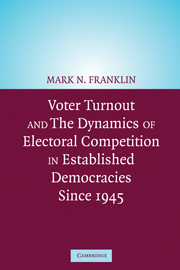Book contents
- Frontmatter
- Contents
- Figures
- Tables
- Preface
- The Authors
- Introduction
- 1 Confronting the Puzzles of Voter Turnout
- 2 A New Approach to the Calculus of Voting
- 3 The Role of Generational Replacement in Turnout Change
- 4 Rational Responses to Electoral Competition
- 5 Explaining Turnout Change in Twenty-Two Countries
- 6 The Character of Elections and the Individual Citizen
- 7 Understanding Turnout Decline
- 8 The Turnout Puzzles Revisited
- APPENDICES
- Bibliography
- Author Index
- Subject Index
2 - A New Approach to the Calculus of Voting
Published online by Cambridge University Press: 08 February 2010
- Frontmatter
- Contents
- Figures
- Tables
- Preface
- The Authors
- Introduction
- 1 Confronting the Puzzles of Voter Turnout
- 2 A New Approach to the Calculus of Voting
- 3 The Role of Generational Replacement in Turnout Change
- 4 Rational Responses to Electoral Competition
- 5 Explaining Turnout Change in Twenty-Two Countries
- 6 The Character of Elections and the Individual Citizen
- 7 Understanding Turnout Decline
- 8 The Turnout Puzzles Revisited
- APPENDICES
- Bibliography
- Author Index
- Subject Index
Summary
In Chapter 1 we saw that the attempt to explain voter turnout without reference to the instrumental motivations of voters gives rise to a number of puzzles, and we asserted that those puzzles would be easier to resolve if we could derive a calculus of voting that made it rational for individuals to take account of the political benefits they might enjoy as a consequence of the electoral victory of one party or candidate rather than another.
It is perhaps somewhat brave of us to think that we can, in this book, resolve a paradox that has baffled some of the best minds in the profession over several decades. However, it is clear that contemporary political scientists know a great deal about the voting act that was not known to Riker and Ordeshook when they published their seminal article in 1968. With the benefit of this knowledge (and building on several advances in rational choice theorizing about individual decision-making in the context of collective action) we are able to put forward a rationale for the voting act that makes it quite understandable that voters would turn out in greater numbers in elections that aggregate-level findings tell us should indeed be high-turnout elections.
We acknowledge, as have many following Downs (1957) and Olson (1965), that voters face two collective action problems when it comes to voting: gathering enough information to form a preference among the candidates or issues, and expending the effort required to cast a ballot.
- Type
- Chapter
- Information
- Voter Turnout and the Dynamics of Electoral Competition in Established Democracies since 1945 , pp. 37 - 58Publisher: Cambridge University PressPrint publication year: 2004



